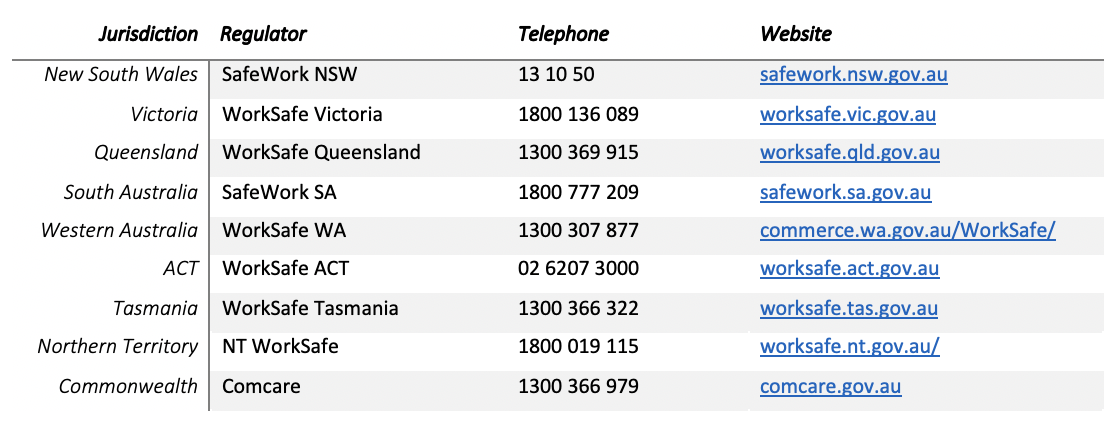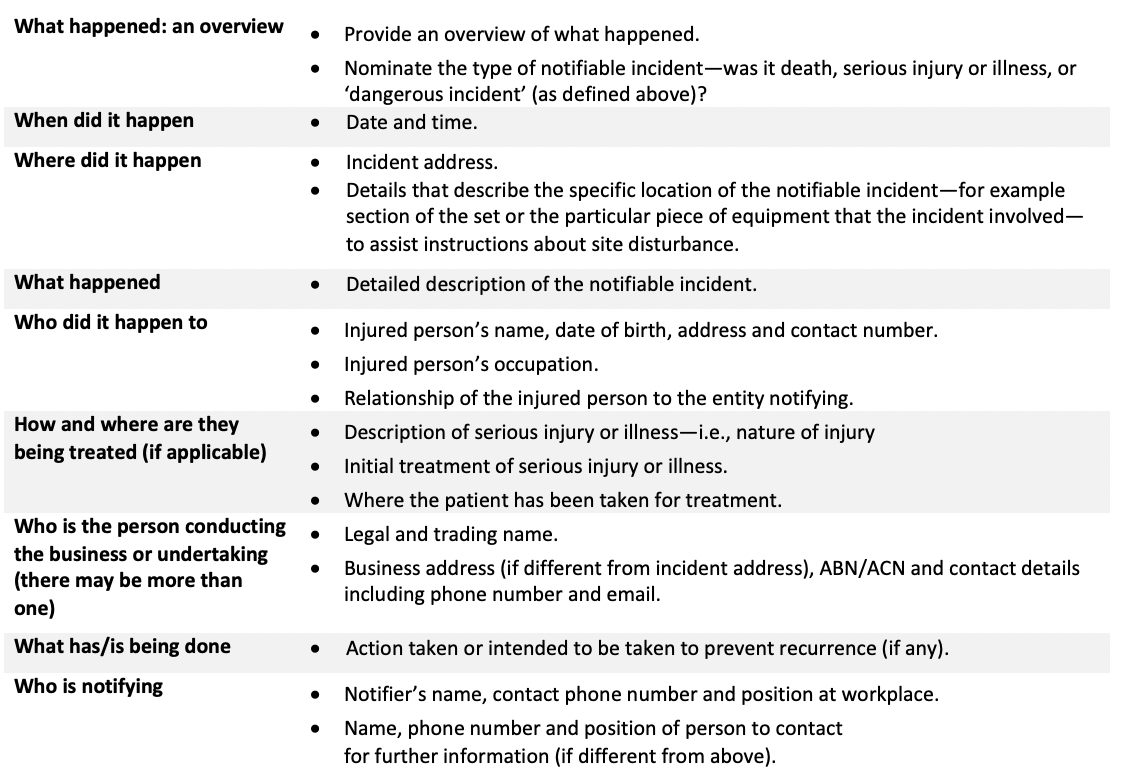
Incident Response and Emergencies
This section covers what you must do at first instance if, despite your precautions, there is an emergency or a dangerous incident (including near misses), injury, illness, or death in your workplace.
+ Golden Rules
- Ensure that you have workers compensation insurance in place as required by law.
- Do not disturb the site of an incident, except to provide aid to an injured person or prevent further injury or damage.
- You must report serious workplace incidents to your state regulatory authority.
- You must report worker injuries to your workers compensation insurer.
- In case of Emergency, it is crucial to have an effective, project-specific Emergency Plan, with designated Wardens, Exit Points and Assembly Areas.
+ Workers' compensation insurance
Workers' compensation insurance is compulsory for all employers in every Australian state and territory. Any business that employs or hires workers on a full-time, part-time, or casual basis, under an oral or written contract of service or apprenticeship, must have workers compensation insurance that covers those workers.
If a worker suffers a workplace injury or disease, the workers compensation scheme may provide the injured worker with weekly benefits, medical and hospital expenses, rehabilitation services, certain personal items, and a lump sum payment for permanent impairment.
Workers’ compensation schemes are administered in different ways in each state, and insurers may have different roles within the schemes. In Western Australia, Tasmania, Northern Territory and ACT, insurers privately underwrite the scheme. In NSW, Victoria and South Australia, insurers operate as scheme agents on behalf of the government authority. In Queensland, the scheme is operated entirely by the state.
+ Incident reporting - 'Notifiable Incidents'
The WHS law requires the PCBU to:
- report any ‘Notifiable Incident’ to the state regulator as soon as the PCBU becomes aware of it; and
- preserve the incident site until an inspector arrives (subject to some exceptions).
There are penalties for failing to provide notification ranging from over $10,000 for an individual to over $60,000 for a company.
NOTIFIABLE INCIDENTS
A Notifiable Incident is:
- the death of a person;
- a ‘serious injury or illness, including:
- any hospital admission;
- treatment for serious injury to any part of the body, including amputations, burns, lacerations, spinal injury;
- exposure to a substance;
- loss of bodily function; and
- infection where the work is a significant contributing factor; or
- a ‘dangerous incident’ (even if no-one is injured) where a person is exposed to serious risk due to situations such as:
- leakage of a gas, pressurised substance, liquid, or other material;
- uncontrolled explosion or fire;
- electric shock;
- falls of heavy objects; and
- collapse of structure or excavation.
To notify a ‘Notifiable Incident’ contact your local regulator:

FORM OF NOTIFICATION
The form of notification will be prescribed by the state regulator, however typically the PCBU will be required to provide a clear description of the incident, with as much detail as possible:

The PCBU must also provide the regulator with any new information if the situation changes – for example if a serious injury results in the person’s death.
Records of Notifiable Incidents must be kept for at least 5 years. It is also useful to keep a record of having made the notification, including any confirmation you have received, and of any directions or authorisations given by an inspector at the time of notification.
SITE PRESERVATION – CONTINUATION OF WORK
An incident site must not be disturbed until an inspector arrives at the site or directs otherwise. The PCBU is responsible for preserving the incident site, so far as is reasonably practicable.
Any evidence that may assist an inspector to determine the cause of the incident must be preserved - including any plant, substance, structure, or thing associated with the incident.
However, preserving an incident site does not prevent any action needed:
- to assist an injured person;
- to remove a deceased person;
- to make the site safe or to minimise the risk of a further notifiable incident; or
- to facilitate a police investigation.
The sooner the regulator is notified, the sooner the site can be released.
An inspector may issue a non-disturbance notice, if they consider that the incident site should remain undisturbed to facilitate their investigation. This notice must specify the period for which the notice is to apply—no more than seven days.
Penalties apply if an individual or body corporate fails to preserve a site.
Requirements to preserve a site only apply to the area where the incident occurred—not the whole workplace.
If you are unsure about what you need to do, you can ask the regulator for advice or to be excused from having to preserve the site.
WORKERS’ COMPENSATION INSURER
In additional to notifying your state WHS regulator of any incident – you must also notify your workers compensation insurer of any injury. In NSW this must be done within 48 hours.
+ Emergencies
This section outlines some general principles in relation to dealing with an emergency. It does not replace the specific and detailed provisions of an Emergency Plan which must be developed for each project at the pre-production stage in accordance with Section C.
ASSEMBLY AREA
PCBU must designate an Assembly Area for each location: a predetermined external area which is used when a building is evacuated. This area is established to check that persons are accounted for, to brief persons evacuated on future action and to prevent re-entry. All Crew must be aware of their nearest Assembly Area and the exit routes leading there.
WARDENS
PCBU must designate Warden(s) for each location and maintain a list with up-to-date contact details. Wardens should be persons whose day-to-day work tends to keep them at the location. Wardens are appointed based on at least one for every twenty persons (with a minimum of two for each area), to ensure that sufficient Wardens are available at all times.
Wardens must be familiar with all aspects of the Emergency Plan. Wardens should be trained in the use of firefighting equipment and be prepared to operate it to extinguish a small fire if it is safe to do so.
Upon receipt of an alarm, or being made aware of an emergency, the Warden will determine the nature of the emergency and activate the Emergency Plan. The Warden will call 000 to notify the Fire Brigade or other Emergency Services and assume control of the location until their arrival.
The primary duty of Wardens is not to combat emergencies, but to ensure, as far as practicable, the safety of crew, cast, extras and members of the public and their orderly evacuation from a hazardous area. All directions given by Wardens in respect of evacuating a building need to be obeyed in full.
The Warden appointed for any part of the location have the authority to evacuate their area if they consider there is danger to any person. The Warden should be aware of the layout of their areas, in particular all escape routes. They should know of the location and identity of other Wardens. Wardens should be familiar with the location and operation of firefighting equipment installed in their area. They should regularly inspect this equipment to ensure it is always available and operable. The Warden should be aware of any mobility impaired, sight or hearing-impaired persons in their area who may require assistance during an evacuation.
MEDICAL EMERGENCY
Ensure that no one in the area is in danger. Call 000 to request ambulance. Arrange for a person to meet the ambulance and escort them to the location of the sick/injured patient.
Arrange for first aid to be administered by a qualified first aid person who should remain with patient/s until not required by medial/para-medical officers.
FIRE EXTINGUISHERS, HOSES AND BLANKETS
The acronym PASS is a simple method of remembering how to operate a fire extinguisher:
- P - Pull the pin: There is an anti-tamper tag fitted that prevents the pin being withdrawn accidentally. It is broken by a sharp tug. Pulling the pin arms the extinguisher.
- A - Aim the extinguisher: If the extinguisher has a hose, then the hose is aimed at the fire. On smaller extinguishers that do not have a hose, aim the extinguisher.
- S - Squeeze the handle: To operate the extinguisher, the handle is squeezed.
- S - Sweep: Sweep the extinguishing agent across the fire. Attack the fire from front to back and from bottom to top.
Prior to attacking the fire, give the extinguisher a short test to ensure that it operates correctly. Ensure you have a safe exit should the fire become uncontrollable. Do not allow the fire to block your escape route. Start attacking the fire from a distance, moving in closer as the fire dies down. A crouching attitude should be adopted to protect yourself against smoke and heat. When in the open, attack the fire from the windward side. This allows the wind to blow the extinguishment onto the fire.
Hose reels should be in strategic positions for the use of the occupants of the building/area to combat small Class A (ordinary combustibles) fires involving items such as paper, wood and plastics. Do not use a hose reel on a fat fires or fire involving electrical appliances.
Fire blankets may be located adjacent to the applicable risk, such as near stoves in kitchens. They may be used on flammable liquid containers such as deep fat fryers, frying pans and small electrical appliances. Take the blanket out package, cover the object with the blanket, turn off the source of heat, leave until cool, then call the Fire Brigade.
SPILLS OF FLAMMABLE LIQUID OR TOXIC SUBSTANCES
In the event of a flammable liquid spill or the spill or accidental release of a toxic substance at the location, Warden(s) will:
- notify the Emergency Services and alert other Wardens;
- evacuate people in the immediate area to a position well up-wind of the spill; and
- where spill occurs outside of an occupied building, Warden will direct persons to remain in the building, close all windows and doors, and shut down the air conditioning.
A gas leak in a building is dangerous for the occupants. Recirculating of the internal air in the air conditioning system means the gas could be circulated to other floors and areas. The gas can be ignited by heart, sparks or flames and is explosive when mixed with air. In the event of a gas leak, the Warden will:
- have the gas supply shut down;
- contact Police and Fire Brigade;
- shut down air conditioning system;
- eliminate ignition sources;
- evacuate the location occupants to an area well up-wind from the incident; and
- keep unauthorised personnel away from the building.
BOMB THREATS
An accurate analysis of the telephone threat can provide valuable information on which to base recommendations, action and subsequent investigation. The person receiving the bomb threat by telephone should:
- try to remain calm;
- let caller finish message;
- keep caller on the line as long as possible;
- DO NOT HANG UP PHONE – the telephone company may be able to trace the call; and
- obtain as much information as possible about the bomb.
Notify police as soon as possible. Every threat must be treated as genuine until proven otherwise.
In the evacuation of the building, if it is safe to do so, windows and doors should be left open to lessen the damage of an internal explosion. Building occupants should take with them those personal belongs which are close at hand, thus making the search for a suspect object easier. The public address system should not be used for announcements of an evacuation for a bomb threat. Panic can be avoided by sensible use of the telephone and word of mouth, especially in the threatened floor or area. Wardens should request occupants to visually check their area for any suspicious items as they evacuate their room or area.
CIVIL DISORDER/DEMONSTRATIONS
On becoming aware of civil disorder occurring in the vicinity of the production, Warden will:
- notify Police, other Wardens and Security (if applicable);
- ensure that occupants lock doors and windows, and otherwise restrict entrance to the location;
- avoid contact with demonstrators; and
- follow instructions of Police and Chief Warden.